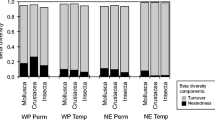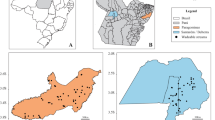Abstract
The rapid decrease of biodiversity and limited resources for surveying it have forced researchers to devise short-cuts for biodiversity surveys and conservation planning. These short-cuts include environmental surrogates, higher taxon surrogates, indicator species and indicator groups. We considered indicator groups as surrogates for wholesale biodiversity and cross-taxon congruence in biodiversity patterns in littoral macroinvertebrates of boreal lakes. Despite the fact that we considered indicator groups amongst a wide variety of taxa, such as two-winged flies, mayflies, caddisflies, beetles, bugs and molluscs, none of the proposed groups possessed all of the qualities of a good indicator taxon for biodiversity surveys and conservation planning. We found generally weak, yet typically significant, relationships between the proposed indicator groups and remaining taxa in both species richness and assemblage similarity. Low congruence was paralleled by somewhat differing relationships of the taxonomic groups to various environmental features of lakes. Furthermore, the relationships of most indicator groups to the environmental features of lakes were not particularly strong. The present findings are unfortunate, because indicator groups did not perform well in predicting the wholesale biodiversity of littoral macroinvertebrates. Thus, there appears to be no short-cut for considering all groups of macroinvertebrates in biodiversity surveys, conservation planning and characterisation of environmental relationships of lake littoral assemblages.


Similar content being viewed by others
References
Allen AP, Whittier TR, Larsen DP, Kaufman PR, O’Connor RJ, Hughes RM, Stemberger RS, Dixit SS, Brinkhurst RO, Herlihy AT, Paulsen RG (1999a) Concordance of taxonomic richness patterns across multiple assemblages in lakes of the northeastern United States. Can J Fish Aquat Sci 56:739–747. doi:10.1139/cjfas-56-5-739
Allen AP, Whittier TR, Larsen DP, Kaufman PR, O’Connor RJ, Hughes RM, Stemberger RS, Dixit SS, Brinkhurst RO, Herlihy AT, Paulsen RG (1999b) Concordance of taxonomic composition patterns across multiple assemblages: effects of scale, body size and land use. Can J Fish Aquat Sci 56:2029–2040. doi:10.1139/cjfas-56-11-2029
Andelman SJ, Fagan WF (2000) Umbrellas and flagships: effective conservation surrogates or expensive mistakes? Proc Natl Acad Sci USA 97:5954–5959. doi:10.1073/pnas.100126797
Balmford A, Long A (1995) Across-country analyses of biodiversity congruence and current conservation effort in the tropics. Conserv Biol 9:1539–1547. doi:10.1046/j.1523-1739.1995.09061539.x
Bilton DT, MacAbendroth L, Bedford A, Ramsay PM (2006) How wide to cast the net? Cross-taxon congruence of species richness, community similarity and indicator taxa in ponds. Freshw Biol 51:578–590. doi:10.1111/j.1365-2427.2006.01505.x
Briers RA, Biggs BJ (2003) Indicator taxa for the conservation of pond invertebrate diversity. Aquat Conserv: Mar Freshw Ecosyst 13:323–330. doi:10.1002/aqc.576
Clarke KR, Gorley RN (2006) PRIMER v6. User manual and tutorial. PRIMER-E, Plymouth
Clarke KR, Warwick RM (2001) Change in marine communities. An approach to statistical analysis and interpretation. PRIMER-E, Plymouth
Cranston P (ed) (1995) Chironomids. From genes to ecosystems. CSIRO, Melbourne
Dillon RT (2000) The ecology of freshwater molluscs. Cambridge University Press, Cambridge
Downing JA, Prairie YT, Cole JJ, Duarte CM, Tranvik LJ, Striegl RG, McDowell WH, Kortelainen P, Caraco NF, Melack JM, Middelburg JJ (2006) The global abundance and size distribution of lakes, ponds, and impoundments. Limnol Oceanogr 51:2388–2397
Faith DP, Walker PA (1996a) How do indicator groups provide information about the relative biodiversity of different sets of areas? On hotspots, complementarity and pattern-based approaches. Biodivers Lett 3:18–25. doi:10.2307/2999706
Faith DP, Walker PA (1996b) Environmental diversity: on the best-possible use of surrogate data for assessing the relative biodiversity of sets of areas. Biodivers Conserv 5:399–415. doi:10.1007/BF00056387
Flather CH, Wilson KR, Dean JD, McComb WC (1997) Identifying gaps in conservation networks: of indicators and uncertainty in geographic-based analyses. Ecol Appl 7:531–542. doi:10.1890/1051-0761(1997)007[0531:IGICNO]2.0.CO;2
Fleishman E, Thomson JR, MacNally R, Murphy DD, Fay JP (2005) Using indicator species to predict species richness of multiple taxonomic groups. Conserv Biol 19:1125–1137. doi:10.1111/j.1523-1739.2005.00168.x
Gaston KJ (1996) Biodiversity—congruence. Prog Phys Geogr 20:105–112. doi:10.1177/030913339602000108
Gaston KJ (2000) Global patterns of biodiversity. Nature 405:220–227. doi:10.1038/35012228
Hanson PC, Carpenter SR, Cardillo JA, Cole MT, Winslow LA (2007) Small lakes dominate a random sample of regional lake characteristics. Freshw Biol 52:814–822. doi:10.1111/j.1365-2427.2007.01730.x
Heino J (2008a) Patterns of functional biodiversity and function-environment relationships in lake littoral macroinvertebrates. Limnol Oceanogr 53:1446–1455
Heino J (2008b) Influence of taxonomic resolution and data transformation on biotic matrix concordance and assemblage-environment relationships in stream macroinvertebrates. Boreal Environ Res 13:359–369
Heino J, Mykrä H (in press) Among-taxon congruence and species richness-environment relationships in stream insects: implications for conservation planning. In: Fattorini S (ed) Insect ecology and conservation. Research Signpost, Kerala
Heino J, Muotka T, Paavola R, Paasivirta L (2003) Among-taxon congruence in biodiversity patterns: can stream insect diversity be predicted using single taxonomic groups? Can J Fish Aquat Sci 60:1039–1049. doi:10.1139/f03-081
Heino J, Paavola R, Virtanen R, Muotka T (2005) Searching for biodiversity indicators in running waters: do bryophytes, macroinvertebrates, and fish show congruent diversity patterns? Biodivers Conserv 14:415–428
Howard PC, Viskanic P, Davenport TRB, Kigenyi FW, Baltzer M, Dickinson CJ, Swanga SL, Matthews RA, Bamlford A (1998) Complementarity and the use of indicator groups for reserve selection in Uganda. Nature 394:472–475. doi:10.1038/28843
Kati V, Devillers P, Dufrene M, Legakis A, Vokou D, Lebrun P (2004) Testing the value of six taxonomic groups as biodiversity indicators at a local scale. Conserv Biol 18:667–675. doi:10.1111/j.1523-1739.2004.00465.x
Lawler JJ, White D, Sifneos JC, Master LL (2003) Rare species and the use of indicator groups for conservation planning. Conserv Biol 17:875–882. doi:10.1046/j.1523-1739.2003.01638.x
Legendre P, Legendre L (1998) Numerical ecology. Elsevier, Amsterdam
Lillehammer A (1988) Stoneflies (Plecoptera) of Fennoscandia and Demark. Fauna Entomol Scand 21:1–165
McCune B, Grace JB (2002) Analysis of ecological communities. MjM Software, Oregon
McGeogh MA (1998) The selection, testing and application of terrestrial insects as bioindicators. Biol Rev Camb Philos Soc 73:181–201. doi:10.1017/S000632319700515X
Negi HR, Gadgil M (2002) Cross-taxon surrogacy of biodiversity in the Indian Garhwal Himalaya. Biol Conserv 105:143–155. doi:10.1016/S0006-3207(01)00158-6
Nilsson AN, Holmen M (1995) The aquatic Adephaga of Fennoscandia and Denmark. Volume 2: Dytiscidae. Fauna Entomol Scand 32:1–188
Noss RF (1990) Indicators for monitoring biodiversity: a hierarchical approach. Conserv Biol 12:822–835
Oertli S, Müller A, Steiner D, Breitenstein A, Dorn S (2005) Cross-taxon congruence of species diversity and community similarity among three insect taxa in a mosaic landscape. Biol Conserv 126:195–205. doi:10.1016/j.biocon.2005.05.014
Oliver I, Beattie AJ, York A (1998) Spatial fidelity of plant, vertebrate, and invertebrate assemblages in multiple-use forests in Eastern Australia. Conserv Biol 12:822–835. doi:10.1046/j.1523-1739.1998.97075.x
Olsgard F, Brattegard T, Holthe T (2003) Polychaetes as surrogates for marine biodiversity: lower taxonomic resolution and indicator groups. Biodivers Conserv 12:1033–1049. doi:10.1023/A:1022800405253
Paavola R, Muotka T, Virtanen R, Heino J, Kreivi P (2003) Are biological classifications of headwater streams concordant across multiple taxonomic groups. Freshw Biol 48:1912–1923. doi:10.1046/j.1365-2427.2003.01131.x
Pearson DL (1994) Selecting indicator taxa for the quantitative assessment of biodiversity. Philos Trans R Soc Lond Ser B 345:75–79. doi:10.1098/rstb.1994.0088
Pearson DL, Cassola F (1992) World-wide species richness patterns of tiger beetles (Coleoptera: Cicindelidae): indicator taxon for biodiversity and conservation studies. Conserv Biol 6:376–391. doi:10.1046/j.1523-1739.1992.06030376.x
Pharo EJ, Beattie AJ, Binns D (1999) Vascular plant biodiversity as a surrogate for bryophyte and lichen diversity. Conserv Biol 13:282–292. doi:10.1046/j.1523-1739.1999.013002282.x
Pinder LCV (1986) Biology of freshwater Chironomidae. Annu Rev Entomol 31:1–23
Ricketts TH, Dinerstein E, Olson DM, Loucks C (1999) Who’s where in North America. Bioscience 49:369–381. doi:10.2307/1313630
Rosenberg DM, Resh VH (1996) Use of aquatic insects in biomonitoring. In: Merritt RW, Cummins KW (eds) An introduction to the aquatic insects of North America. Kendall/Hunt, Dubuque, pp 87–97
Savage AA (1989) Adults of the British aquatic Hemiptera Heteroptera. A key with ecological notes. Freshw Biol Ass Sci Publ 50:1–173
SPSS Inc (2002) SPSS version 11.5 for Windows. Chicago, Illinois
Su JC, Debinski DM, Jakubauskas ME, Kindscher K (2004) Beyond species richness: community similarity as a measure of cross-taxon congruence for coarse-filter conservation. Conserv Biol 18:167–173. doi:10.1111/j.1523-1739.2004.00337.x
Vessby K, Söderström B, Glimskär A, Svensson B (2002) Species richness correlations of six different taxa in Swedish seminatural grasslands. Conserv Biol 16:430–439. doi:10.1046/j.1523-1739.2002.00198.x
Vinson MA, Hawkins CP (2003) Broad-scale geographical patterns in local stream insect genera richness. Ecography 26:751–767. doi:10.1111/j.0906-7590.2003.03397.x
Acknowledgements
The field work of this study was financed by grants from the Academy of Finland to J. Heino and T. Muotka. We thank P. Majuri and K. Sivonen for conducting the field work. Oulanka Research Station provided logistic support throughout the study.
Author information
Authors and Affiliations
Corresponding author
Rights and permissions
About this article
Cite this article
Heino, J., Tolonen, K.T., Kotanen, J. et al. Indicator groups and congruence of assemblage similarity, species richness and environmental relationships in littoral macroinvertebrates. Biodivers Conserv 18, 3085–3098 (2009). https://doi.org/10.1007/s10531-009-9626-2
Received:
Accepted:
Published:
Issue Date:
DOI: https://doi.org/10.1007/s10531-009-9626-2




